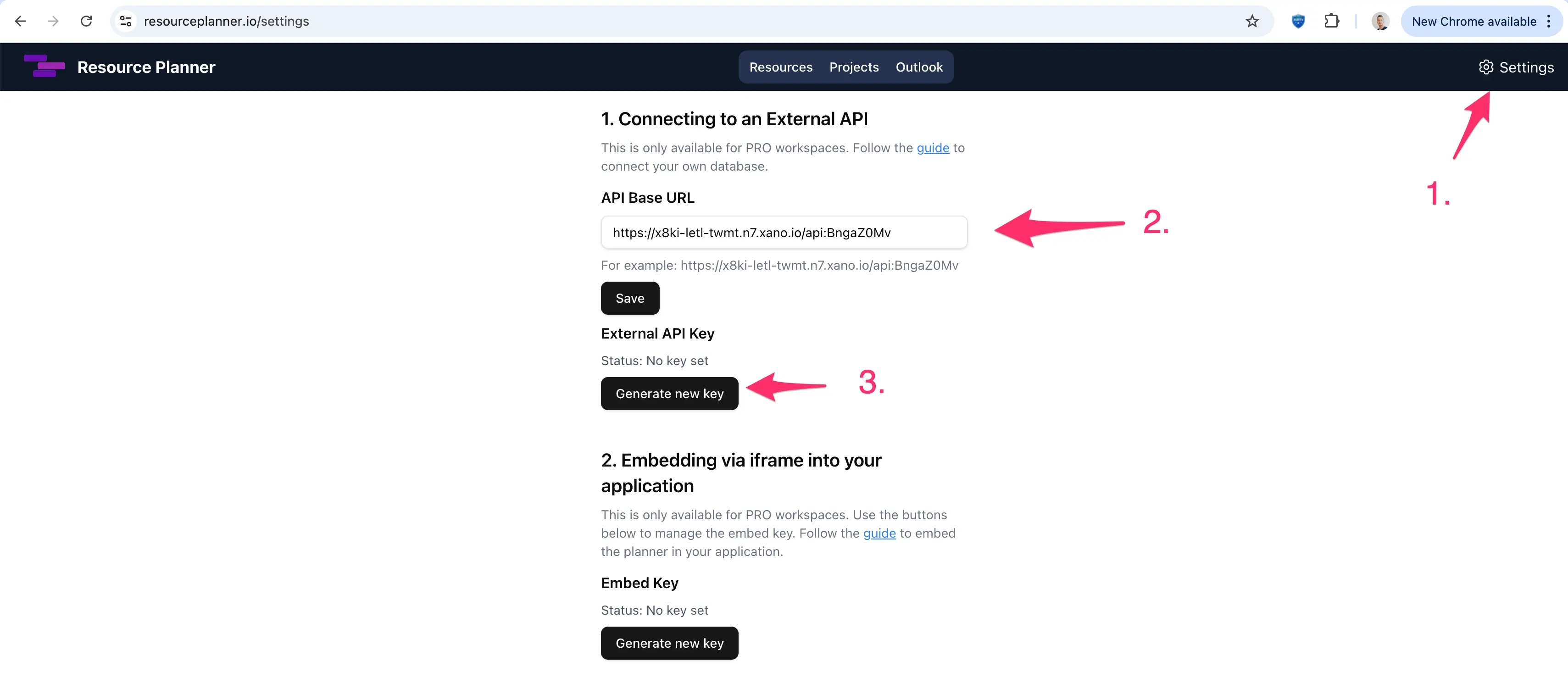Developer Integration Guide – Resource Planning API
Last Updated: September 6, 2025
1. Overview of the Data Model
This document explains how third‑party developers can integrate an external data source with the application. You configure your own API base URL, and the app's server proxies requests to your API.

The application works with three core entities:
- Resources – people or assets that can be assigned to projects. Minimum fields:
id,name,email,capacity(decimal), andwork_days(array of integers 1–7). - Projects – initiatives resources can be scheduled against. Supported ields:
id,title, optionalnote,color(any hex colot, but we recommend avoiding gray, red and green as these are colors we use for statuses). - Assignments – link a resource to a project with a date range and a daily allocation. Fields:
id,project_id,resource_id,date_from,date_to,hours_per_day, optionalnote.
2. API Endpoints
The server proxies requests to your configured apiBaseUrl. Endpoints should be relative to your API root and return JSON. You should have the following endpoints, so the app works correctly:
2.1 /loadData
On GET, should return all resources, projects, and assignments in a single payload:
{
"resources": [
{
"id": 1,
"name": "Alice",
"email": "alice@example.com", // optional
"capacity": 37.5,
"work_days": [1, 2, 3, 4, 5]
}
],
"projects": [
{
"id": 42,
"title": "Migration Project",
"note": "Phase 1 rollout", // optional
"color": '#D71DF4', // optional
"enum_status_id": 1
}
],
"assignments": [
{
"id": 7,
"project_id": 42,
"resource_id": 1,
"date_from": "2025-09-01",
"date_to": "2025-09-10",
"hours_per_day": 8,
"note": "Polishing UI", // optional
}
]
}2.2 /resources
| Method | Endpoint | Description |
|---|---|---|
| POST | /resources | Create a resource; return the created record. For example: |
| PUT | /resources/{id} | Update a resource return the updated record. For example: |
| DELETE | /resources/{id} | Delete a resource and its assignments; return status 200. We try to delete all assignments of this resource on external API, but we don't block the operation if it fails. |
2.3 /projects
| Method | Endpoint | Description |
|---|---|---|
| POST | /projects | Create a project; return the created record. For example: |
| PUT | /projects/{id} | Update a project; return the updated record. For example: |
| DELETE | /projects/{id} | Delete a project (and its assignments); return status 200. We try to delete all assignments of this project on external API, but we don't block the operation if it fails. |
2.4 /assignments
| Method | Endpoint | Description |
|---|---|---|
| POST | /assignments | Create an assignment; return the created record. For example: |
| PUT | /assignments/{id} | Update an assignment; return the updated record. For example: |
| DELETE | /assignments/{id} | Delete an assignment; return status 200. |
3. Authentication & Workspace selection
Protect your API with authentication. The planner's server signs outbound requests with Authorization: Bearer <KEY>.
Since requests originate from our server to yours, typical browser CORS restrictions do not apply. Ensure your API allows requests from our deployment environment (standard server‑to‑server access).
4. Normalisation and Data Conversion
- Dates: Provide ISO 8601 strings (
YYYY-MM-DD). The client parses them to Dates. - Numbers:
hours_per_dayis converted to a float. Prefer dot as decimal separator. - IDs: Numeric IDs are accepted and coerced to strings internally.
- Work days:
work_daysis an array of integers 1–7 (Mon–Sun).
5. Example Workflow
- Initial data load – Client calls
GET /loadDataand normalises the response. - Creating a project –
POST /projects; - Creating a resource –
POST /resources; - Assigning a resource –
POST /assignments; with respectiveresource_idand project_id. - Updating or deleting –
PUT/DELETEthe relevant entity. We do optimistic updates on client, but we show error messages on failure, so user can reload the page.